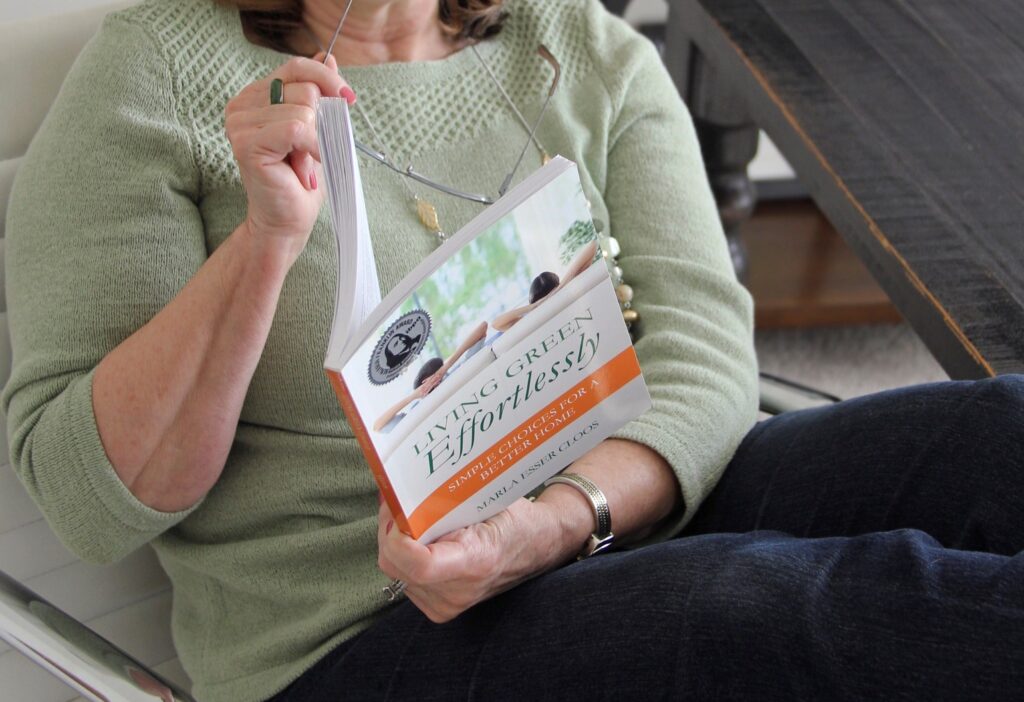
I’m Marla, your Green Home Coach. Thank you for joining me on this journey to make your home healthier, more comfortable, and safer. In this series we’ll continue discussing my book, Living Green Effortlessly – Simple Choices for a Better Home, where I share tips on making more educated and better choices for our homes that can have a big impact on how we live in them.
We’ll cover the basics of all the systems and features of your home, including how to make the best of all the features. Each piece of this series will cover a chapter in the book, where we’ll read some excerpts and the stories that go along with them. Today, we’ll be discussing Chapter Two: Your Comfort, Health, and Safety: Start Where You Live.
The roof, walls, windows, floors, and doors keep you safe, warm, and comfortable inside your house. The roof and gutters handle the rain and snow, while insulation in the walls, under the roof, and in the basement ceiling acts as a sweater for your home, keeping the heated air inside during the winter and cooled air inside in the summer.
No matter what your house is made of, it provides an envelope of protection from the elements. However, there are still places in that envelope where outdoor elements can get in, and where the energy you pay for can get out. To save money and stay comfortable in your home, focus on sealing and insulating the envelope of your house.
Our homes have become everything since Covid hit. They are where we work, play, cook, gather, relax, and work out. It’s time to consider if you have changed the way you think about your home or if there are any things about it you might want to change or do differently.
I want to help you find ways to make your home more comfortable, healthier, and better suited to support you.
A tight home is an efficient home. Using quality building materials is necessary to prevent moisture problems, component wear, and pollutants in the air.
Finding air leaks can be a challenge. You may consider hiring a pro like a home energy assessor or auditor to help, or you can find leaks and seal them yourself. Your local hardware store can help you find the right materials for your particular application.
Insulation works better when air leaks are plugged, so look out for tiny holes in the insulation of the attic. If you find any, plug them up to help you stay warm in the winter and cool in the summer.
A tight building envelope does not allow fresh air to enter the home unless you make it happen.
Good ventilation is critical for maintaining air quality and preventing health problems. You can achieve this by either opening windows or using the HVAC system.
Investing in custom-made anti-allergy Green Screen air filters for your HVAC system can help improve air quality. You can also add an air purifier and advanced filtration system if needed.
Don’t forget to run the exhaust fans in your bathrooms whenever they get steamy, or have an automated system put in place.
Plants also help to clean the air. NASA has compiled a list of about ten plants that work well for doing that.
Since dust is largely composed of dead skin cells, it can harbor germs and should be removed from your home. The most effective methods for doing so are vacuuming and using a damp microfiber cloth.
To ensure your cleaning products are non-toxic and safe for use at home, consider consulting the Environmental Working Group’s list of ranked products. Additionally, you can find various recipes for DIY cleaning solutions online or in books. Keep in mind the motto of simplifying your cleaning routine, and remember that small steps towards a greener lifestyle are easier than you may expect.
In summary, to keep your home clean and healthy, it’s important to regularly remove dust which can carry germs. Vacuuming is the most effective method, followed by using a damp microfiber cloth. When it comes to cleaning products, it’s important to choose non-toxic options that are safe for both you and the environment. The Environmental Working Group provides a helpful list of non-toxic products to use, or you can make your own cleaning solutions using recipes found online or in books. Finally, simplifying your cleaning routine can make it easier to maintain a healthy and green home. Remember, making small changes can make a big difference in living a greener life.
My website Green Home Coach
Book: Living Green Effortlessly
Facebook Group: Love Your Everyday Green Home